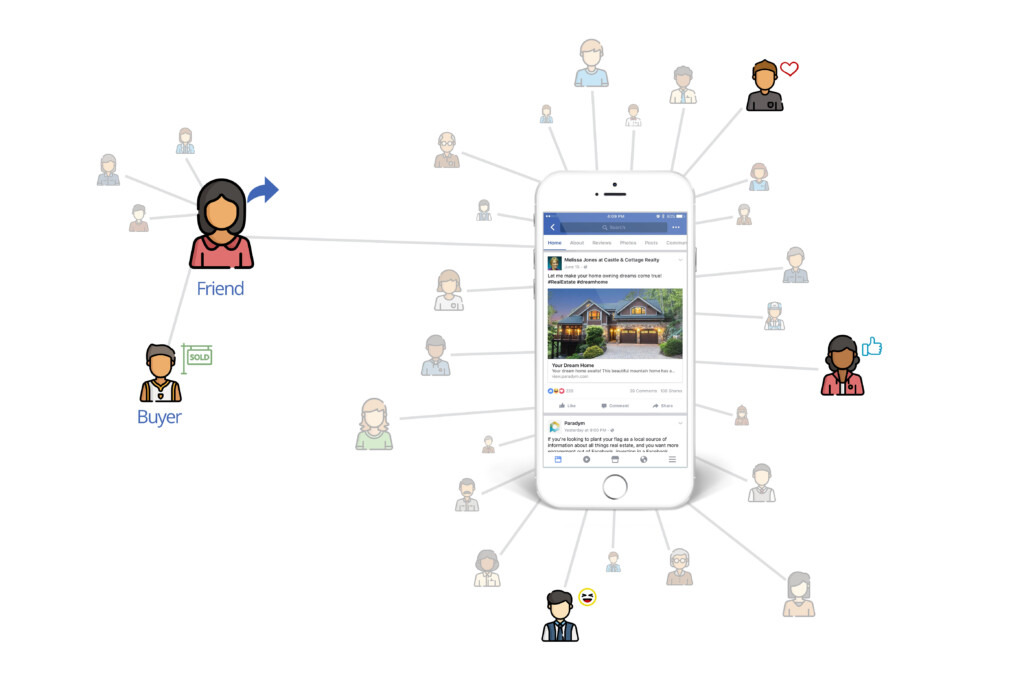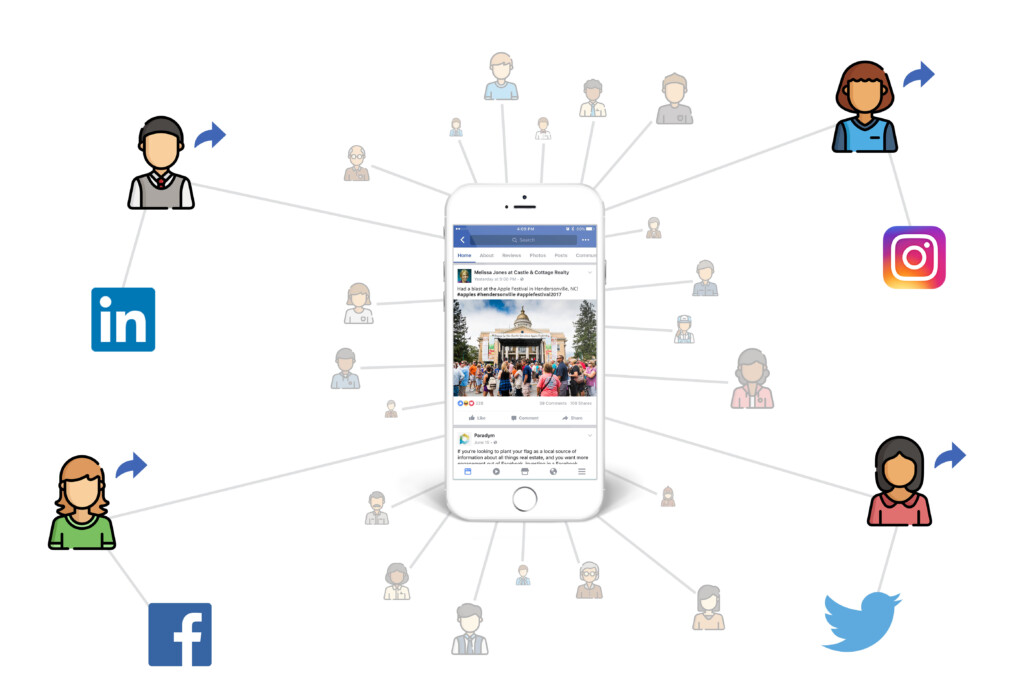The real estate agent’s marketing guide to storytelling
Ready to win more business, build your sphere of influence, and stay top of mind in a tight market? Then it’s time to start telling a story with your marketing.
Welcome to the real estate agent’s marketing guide to storytelling, a resource packed with information that can help you win and promote listings, generate more leads, and better connect with buyers and sellers.
Let’s get started! Feel free to dive right in, or click one of the links below to jump to a section that piques your interest:
Part 1: Why storytelling matters: contributing to your bottom line
Part 2: Storytelling basics: 7 tips for telling a story that sells
Part 3: Properties, places, and people: what kind of story should I tell?
Part 4: Business-building tech tools that make it easier to share your story
Get 189 real estate video marketing ideas in your free copy of the Real Estate Marketing Kickstarter ebook!
Part 1: Why storytelling matters: contributing to your bottom line
Let’s start with a definition of real estate storytelling: Real estate storytelling is a marketing strategy that uses a combination of text, video, social media posts, websites, branding elements, and email to tell an overarching story about the properties, places, and people in a real estate agent’s geographic area. Stories are powerful because they’re engaging, they capture the emotion of potential clients, and they’re more authentic than traditional forms of advertising and marketing. And if you think about it, every sale starts with a story.
Buyers start imagining what it would be like to move. They want to get closer to the city center. Maybe they want to get into a specific school district. Or they just got married and they’re looking for a starter home. And inevitably the search goes online. Before you know it, they’re creating a story about what life would look like if they moved into that home they saw on Facebook. But one thing’s missing. They need another character in the story. Someone who can help them get from point A to point B. They need a real estate professional. 
“Everything you do to market your business is another paragraph, page, or chapter in the story people hear from you. And the story people hear is the one they act (or don’t act) on, and repeat (or don’t repeat) to others.”
– Brian Clark
Does this sound too psychological? Too much like a stretch? It’s not. Think about your own process for buying your home. Was it that different? Smart real estate agents and brokers are aware of how storytelling works, and they use storytelling (sometimes without even knowing it) to paint a picture of a home or neighborhood in a way that captures the attention of would be buyers.
Stories are great marketing tools because they “stimulate both the feelings and imagination of the teller and the audience.”
– Geoff Mead
Stories are relatable, and stories help us remember things. They make connections without beating people over the head. And even if you’re not the best writer, you can still tell an effective story about the properties, places, and people in your market. Here’s some more good news. Digital marketing makes it easier than ever to share your stories with both wide and targeted audiences. Whether you’re using video, social media, blog posts, or advertisements, the internet presents you with tons of opportunities to build your real estate business.
More reasons to tell stories with your marketing
It wasn’t too long ago that advertising and marketing were dominated by “shout-louder” tactics. Flashy colors, crazy fonts, and loud radio and TV ads were go-to promotional activities. But we’re living in a new era. Some call it the age of permission marketing. We’ve gotten really good at tuning things out, and we’ve gotten better at looking for quality content. It turns out that we actually like good marketing. We want more of it. Here’s a helpful way to see the differences:
Old-school marketing tactics
Tell people what they should want, think, or buy.
Be loud, flashy, garrish. Throw your message at people.
Push your message in front of as many people as you possibly can
Tell them about every single feature of the home you’re trying to sell.
Think of people as audiences and numbers and prospects.
Storytelling strategies
Tell a compelling story that people can relate to.
Draw attention to your brand and listings in a way that leaves people wanting more.
Think about your target audience, and create a story that would inspire or entertain them… a story that would draw them in.
Focus on the most important things and tell stories around those.
Think of people as human beings, and think about how your marketing can serve their interests.
Old-school marketing tactics
Storytelling strategies
Be loud, flashy, garrish. Throw your message at people.
Draw attention to your brand and listings in a way that leaves people wanting more.
Push your message in front of as many people as you possibly can
Think about your target audience, and create a story that would inspire or entertain them… a story that would draw them in.
Tell them about every single feature of the home you’re trying to sell.
Focus on the most important things and tell stories around those.
Think of people as audiences and numbers and prospects.
Think of people as human beings, and think about how your marketing can serve their interests.
Big brands do storytelling (think Apple, Starbucks, Coca Cola, etc.), and it works in real estate, too. And beyond just making connections with clients, storytelling can help you win and promote listings, and it’s a powerful tool for growing your sphere of influence.
How storytelling contributes to your bottom line
The way we see it, there are three main ways that storytelling helps real estate professionals generate leads and revenue… First, storytelling helps you win listings. Here’s how…
1) Through branding. How you interact with clients, the promises you make and keep, the logos and colors you use, your website, and your posts on social media all come together to create a brand story. Through all of these interactions with your brand, clients believe you can help sell their home, they buy in to your brand, and they decide to give you the listing opportunity.
2) Community stories highlight the people and places that surround a home. Think photos of a local event shared on social media. Or a video showing off the fare of a new restaurant. Maybe an agent shares a tweet about the renovations at the local park, and they follow up with a Facebook post about the school. All of these community stories demonstrate your ability to creatively tell a story about an area. This can go a long way with sellers. It shows them that you know how to do this digital marketing thing, and you just might be the person who can help tell the story of their home.
3) Stories help us connect with buyers and sellers on a personal level as well. That doesn’t mean you have to share everything that happens in your life. But a lot of agents share family moments, pictures from fun events, or personal “day-in-the-life-of” updates. These personal touches add some authenticity to your overall storyline and can show sellers that you’re approachable, you know the area, you’re just like them, and that can go a long way in giving you and your brand the human touch. And real estate storytelling can help you promote listings as well. Every real estate professional has a story to tell, and there are lots of ways to promote the homes in your inventory with stories. Listing stories, community stories, personal stories, and brand stories are all great tools to add to your marketing toolkit. We’ll get into more specifics (and even give you some practical tips) about how to use these later in the guide.
Telling stories that build your sphere of influence
Your sphere of influence is a critical part of your sales funnel. And with the memory-jogging power and emotional appeal of real estate storytelling, you can reach your sphere with messages that better capture their attention and increase the likelihood that they’ll mention you to a friend. 
“People share, read, and generally engage more with any type of content when it’s surfaced through friends and people they know and trust.”
– Malorie Lucich
Let’s take the next step and start looking at the specifics of how to tell stories that build your real estate business.
Part 2: Storytelling basics: 7 tips for telling a story that sells
So you’re convinced. Real estate storytelling sounds like a great idea, and you’re ready to get started. Your first step is to create a story. Then you’ll share it. Pretty simple, right? Whether you’re writing a blog post or creating a short video, the process is just about the same. Try to limit your story to a single, powerful idea that directly relates to a clear call to action. Consider the flow of your story, do some planning, and dive in!
Here’s a checklist to help you get started…
And it’s usually a good idea to go for a shorter piece of content rather than a longer one. Remember, your audience’s attention span is pretty short these days, and if a story doesn’t entertain, they’ll tune you out. Try using Grammarly and Hemingway to polish your draft.
Tip: If you’re planning to use video or audio to tell your story, make sure you take into account any technical help you may need and any tools you need to gather. And keep in mind you don’t necessarily have to be a professional to create great content. Remember that supercomputer/ video production studio in your pocket or purse (your smartphone) and try your hand at video marketing!
“[T]he more honest you can be about your business, about who you serve and the problems that you solve, the more loyalty you will find.”
– Sonia Simone
Promoting: What’s the use of a good story if no one sees it? With digital marketing you have several options for promoting your content, and generally speaking, it’s a good idea to use a combination of tactics to get the word out about your latest real estate story. Typically promotion will take place on the following channels:
◻︎ Your website
◻︎ Blog
◻︎ Social media
You could even take advantage of automatic posting features to get more mileage out of your stories. Pro tip: Evaluate how people interact with your marketing content, and take note of which channels seem to give you the most return on your investment.
“Fiction stories follow a structure that includes a beginning, a middle, and an end. Your brand stories should follow a similar structure.”
– Susan Gunelius
Now you know enough to be dangerous! We’ve covered some basic ideas around real estate storytelling, and now it’s time to get a little more practical. In the next section we’ll look at a few ideas to kickstart your marketing with 4 fundamental story types.
Part 3: Properties, places, and people: what kind of story should I tell?
Whether you’re loaded down with listings, trying to drum up business, or you’re just getting started, you always have a story to tell. And remember that not every contact in your database may be ready to buy or sell right now. That’s ok. The beauty of storytelling is that you can create various stories that speak to people at different points in the buyer’s journey. And no matter how you label them, stories sell! While the list could go on and on, we’ve found that most real estate stories fall into 4 categories.
Listing stories
Here the home is the central feature. Use listing stories to take prospective buyers on a tour of the property by showcasing the property’s best features with photo, video, and text.
Listing stories serve a dual purpose: they help you promote existing listings, and they can help you win new listings. And learning how to make a real estate listing story is easier than you may think.
Here are a few suggestions to get you moving in the right direction:
◻︎ Create a “front to back” listing story that visually walks potential buyers through a home.
◻︎ Share a “highlights” listing story that focuses on the home’s most valuable features.
◻︎ Use high quality photos and videos to show off the listing and include media showing what the surrounding neighborhood has to offer.
◻︎ Take advantage of storytelling software to save some time 🙌.
Tip: Depending on your schedule, creating and sharing listing stories can be tough. But real estate marketing technology and unlimited support sure can help!
Want to see how Paradym can help you win and promote listings?
Personal stories
Believe it or not, real estate professionals are real people! Why not share a little of your personal side? Personal posts can go a long way in building rapport with prospective clients. Show them they can relate to you, and you may be surprised to see them contacting you when they’re ready to buy or sell. Things like enjoying dinner at a local restaurant, spending time with the family, or taking in a sporting event may seem mundane to you. But these are all great opportunities to snap some photos to share in a personal real estate story. Add some clever text to a collection of these photos and show off the personal side of your brand. Try sharing about…
“A company is nothing more than the story of the people who created it, what brought them to this point, and where they want to go in the future.”
– Chris Warden
Brand stories
Branding is more than just a logo. It’s part of your identity as an agent, broker, or team. It’s everything from the culture of your company to the colors you use on your website. A brand story can highlight the people you work with, you as an agent, your services, your history, or your company culture. What do brand stories look like? Here are a few ideas:
Community stories
Everyone remembers what matters in real estate… “location, location, location.” By telling a good community story, you invite clients into the life of the home’s surroundings. Parks and local amenities matter. Schools really matter! Get creative, interview some folks, and start sharing the dozens of stories you could tell about the street a home is situated on, the history of the neighborhood, what the HOA is like there, etc. What would you add to this list?
Want digital marketing tips from industry pros?
Get your free copy of our Real Estate Marketing with the Pros ebook.
Part 4: Business-building tech tools that make it easier to share your story
Digital marketing technologies make it really easy to share stories online. Just think about it. Never in history has it been so easy to reach out to so many people at once. But even with marketing technologies like social media and email, some agents and brokers find it hard to get the word out about their brand and listings.
That’s where real estate storytelling technology comes in.
“Instead of one-way interruption, web marketing is about delivering useful content at just the precise moment that a buyer needs it.”
– David Meerman Scott
Software
Depending on the kind of software you choose, you could get access to any number of helpful features. Some real estate professionals use a variety of software tools to create a storytelling suite. Others use a more comprehensive software solution, saving time and getting a lot of value for their investment.  Here are some ways you can leverage technology to tell your story:
Here are some ways you can leverage technology to tell your story:
- Automate the mundane, everyday tasks that take your attention away from people and sales activities.
- Automated listing campaigns make creating and sharing your listing stories a lot easier. Some software even pulls information straight from your MLS and automatically combines photos, music, and text to create shareable stories.
- Single property sites are effective and engaging storytelling tools. With Paradym you can even use single property sites to tell the story of a community event or share a branding story.
Want to see how Paradym can help share your stories automatically?
- Automated story publishing is a great tool for the busy real estate agent (learn how this works with Paradym).
- Try using a service like Buffer or Hootsuite to schedule social media posts in advance.
- Real estate marketing is a visual activity, so it’s a great idea to use video whenever you can. Make sure your real estate storytelling software includes video integration.
- Cloud media studios can provide customization features that you can use to crop photos, edit video length, add and edit text, and more.
- It’s time to take your yard signs to the next level! Add a sign rider and bring on site buyers into the property’s story with text & voice codes.
- Virtual reality has been gaining traction in real estate marketing. Consider using 3D tech to tell your listing story. 3D model integration is included with Paradym.
- Use analytics to monitor your success. If you’re going to take the time to create and share real estate stories online, it only makes sense to find out what people are doing with your stories (Are they liking them? Sharing them?).
- Visuals really matter. Up your game with help from Canva.
- Capturing leads is a critical part of digital real estate marketing. After all, you want your stories to generate results! Automatic lead notifications make it easy to connect with potential clients.
- You’re always on the go, so it makes sense to take your marketing with you. Mobile marketing apps put actionable information in the palm of your hand.
- Digital marketing tools are great… if you know how to use them! Support and coaching can go a long way in helping you get the most out of your marketing investment.
Single property sites
Single property websites are efficient and engaging tools for bringing buyers into a home’s story. These sites can be minimally equipped or packed with features, they allow for self-paced navigation, social media connectivity, and they make it really easy to communicate a lot of information about a home.
Video
These days video leads the pack in digital marketing. Buyers want to see the home’s features instead of reading about them, so it makes sense for real estate professionals to take advantage of video whenever they can. And it only takes a brief scroll through your feed on Facebook to notice that something’s changed over the past few years. Video is everywhere! Visit any of the major social media networks, and you’ll see that video is now a major player in content distribution.
From promoting your listings to sharing community stories, video can garner attention and communicate valuable information to prospective buyers and sellers. And don’t worry, video marketing doesn’t always necessitate the use of a professional videographer. Even if you’re a video marketing beginner, you can still tap into the business-building, storytelling power of video. And lots of smartphones can shoot high resolution video, making it quick and affordable to create quality real estate video stories. That said, if your listing or community event requires the professional touch, don’t hesitate to call in a pro!
Social
Do you typically think of social media as a storytelling tool? A lot of real estate professionals see social media merely as a place to post content, missing out on its real value and business-building potential.  Whether you’re posting brand stories, listing stories, or sharing highlights from a recent community event, social media is an incredible (and indispensable) channel for communicating with your sphere. Here are some practical storytelling tips for building your business on social:
Whether you’re posting brand stories, listing stories, or sharing highlights from a recent community event, social media is an incredible (and indispensable) channel for communicating with your sphere. Here are some practical storytelling tips for building your business on social:
Do you get social media? Get help with The Real Estate Agent’s QuickStart Guide to Social Media.
Good stories have a tendency to spread. What better place to spread your real estate stories than on Facebook?
Twitter is the fast-talker of social media, and it’s a great tool for telling a good story… embrace it!
Once upon a time it was the Rolodex. Now it’s LinkedIn. Professional relationships are a goldmine for referrals, so use this social media network to tap those contacts with powerful stories. Note: This may be a good time to mention that each social media network has its own set of “rules.” Instead of sharing the exact same content on all of your social media channels, do a little digging to find out what kinds of posts work best for the platform. For example, LinkedIn is a place for professional conversations, so it makes sense to share things like local market updates, real estate industry news and trends, etc. A good question to ask is ‘what is this platform for?’ and then match your content to fit the conventions of that platform.
Photo, video, live video, text, you name it. Instagram has emerged as a dominant social media platform, and it’s a go-to network for real estate marketing. And with Instagram Stories, it’s easy to upload recent photos and videos to create a compelling story that appears at the top of your followers’ feeds. Check out these 12 things real estate agents should post on Instagram, and start creating (and sharing) some stories of your own.
Tell your story
Stories resonate with us, they capture our imagination, and with the right tools and technology, stories help you better communicate your value to the buyers and sellers who need you. Bookmark this guide, share it with a friend, and start tapping into the power of storytelling today.
Paradym makes it easy to share your stories on social media and popular real estate portals
